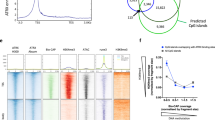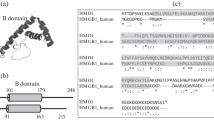Abstract
HMG proteins are abundant chromosomal non-histone proteins. It has been suggested that the HMG proteins may play an important role in the structure and function of chromatin. In the present study, the binding of HMG proteins (HMG1/2 and HMG14/17) to the core DNA sequence of DNaseI hypersensitive site 2 (HS2core DNA sequence, -10681-10970 bp) in the locus control region (LCR) of the human β-like globin gene cluster has been examined by using both thein vitro nucleosome reconstitution and the gel mobility shift assays. Here we show that HMG1/2 can bind to the naked HS2core DNA sequence, however, HMG14/17 cannot. Using thein vitro nucleosome reconstitution we demonstrate that HMG14/17 can bind to the HS2core DNA sequence which is assembled into nucleosomes with the core histone octamer transferred from chicken erythrocytes. In contrast, HMG1/2 cannot bind to the nucleosomes reconstitutedin vitro with the HS2core DNA sequence. These results indicate that the binding patterns between HMG proteins and the HS2core DNA sequence which exists in different states (the naked DNA or thein vitro reconstituted nucleosomal DNA) are quite different. We speculate that HMG proteins might play a critical role in the regulation of the human β-like globin gene’s expression.
Similar content being viewed by others
References
Qian, R. L., Chen, Y. D., Song, Q. B. et al., The binding between HMG proteins and the 5′-flanking DNA sequences of human β-globin gene, Science in China (in Chinese), Ser. B, 1992, 22(10): 1045.
Yan, Z. J., Chen, Y. D., Qian, R. L., The interactions between HMG proteins and the 5′-flanking regulatory elements of human ε-globin gene, Acta Biochimica et Biophysica Sinica (in Chinese), 1998, 30(5): 471.
Forrester, W. C., Epner, E., Driscoll, M. C. et al., A deletion of the human β-globin locus activation region causes a major alteration in chromatin structure and replication across the entire β-globin locus, Genes Dev., 1990, 4(10): 1637.
Goodwin, G. H., Johns, E. W., Isolation and characterization of two calf-thymus chromotin non-histone proteins with high contents of acidic and basic amino acids, Eur. J. Biochem., 1973, 40(1): 215.
Bradford, M. M., A rapid and sensitive method for the quantitation of microgram quantities of protein utilizing the principle of protein-dye binding, Anal. Biochem., 1976, 72: 248.
Rhodes, D., Laskey, R. A., Assembly of nucleosomes and chromotinin vitro, Methods Enzymol., 1989, 170: 575.
Yan, Z. J., Chen, Y. D., Qian, R. L., Developmental stage-specific factors in the mouse hematopoietic tissues binding to the 5’ -flanking cis-acting elements of human ε-globin gene, Chinese Science Bulletin, 1995, 40(7): 778.
Bustin, M., Lehn, D. A., Landsman, D., Structural features of the HMG chromosomal proteins and their genes, Biochimica et Biophysica Acta, 1990, 1049(3): 231.
David, J. T., Peter, L. M., High mobility group proteins 1 and 2 stimulate transcriptionin vitro by RNA Polymerases II and I, J. Biol. Chem., 1986, 261(15): 6986.
Watt, F., Molloy, P. L., HMG-2 stimulate binding of a specific transcription factor to the adenovirus major late promoter, Nucleic Acids Research, 1988, 16(4): 1471.
Shykind, B. M., Kim, J., Sharp, P. A., Activation of the TFIID-TFIIA complex with HMG-2, Gene Dev., 1995, 9(11): 1354.
Verrier, C. S., Roodi, N., Yee, C. J. et al., High-mobility group (HMG) protein HMG-1 and TATA-binding protein-associated factor TAFII30 affect estrogen receptor-mediated transcriptional activation, Mol. Endocrinolog., 1997, 11(8): 1009.
Grosschedle, R., Giese, K., Pagel, J., HMG domain proteins: architectural elements in the assembly of nucleoprotein structures, Trends Genet., 1994, 10(3): 94.
Bianchi, M. E., The HMG-box Domain, London: Oxford University Press, 1995, 177–200.
Lilley, D. M. J., HMG has DNA wrapped up, Nature, 1992, 357(6367): 282.
Bustin, M., Reeves, R., High-mobility-group chromosomal proteins: Architectural components that facilitate chromatin function, Progress in Nucleic Acid Research and Molecular Biology, 1996, 54: 35.
Sandeen, G., Wood, W. I., Felsenfeld, G., The interaction of high mobility proteins HMG14 and 17 with nucleosomes, Nucleic Acida Research, 1980, 8(17): 3757.
Druckmann, S., Mendelson, E., Landsman, D. et al., Immunofractionation of DNA sequences associated with HMG-17 in chromotin, Exp. Cell Research, 1986, 166(2): 486.
Brotherton, T. W., Reneker, J., Ginder, G. D., Binding of HMG17 to mononucleosomes of the Avian β-globin gene cluster in erythroid and non-erythroid cells, Nucleic Acids Research, 1990, 18(8): 2011.
Postnikov, Y. V., Shick, V. V., Belyavsky, A. V. et al., Distribution of high mobility group proteins 1/2, E and 14/17 and linker histones H1 and H5 on transcribed and non-transcribed regions of chicken erythrocyte chromatin, Nucleic Acids Research, 1991, 19(4): 717.
Trieschmann, L., Alfonso, P. J., Crippa, M. P. et al., Incorporation of chromosomal proteins HMG-14/HMG-17 into nascent nucleosomes induces an extended chromatin conformation and enhances the utilization of active transcription complexes, EMBO J., 1995, 14(7): 1478.
Author information
Authors and Affiliations
Corresponding author
Rights and permissions
About this article
Cite this article
Zhao, H., Zhang, S., Jiang, C. et al. Interactions between HMG proteins and the core sequence of DNaseI hypersensitive site 2 in the locus control region (LCR) of the human β-like globin gene cluster. Sci. China Ser. C.-Life Sci. 43, 631–636 (2000). https://doi.org/10.1007/BF02882284
Received:
Issue Date:
DOI: https://doi.org/10.1007/BF02882284




